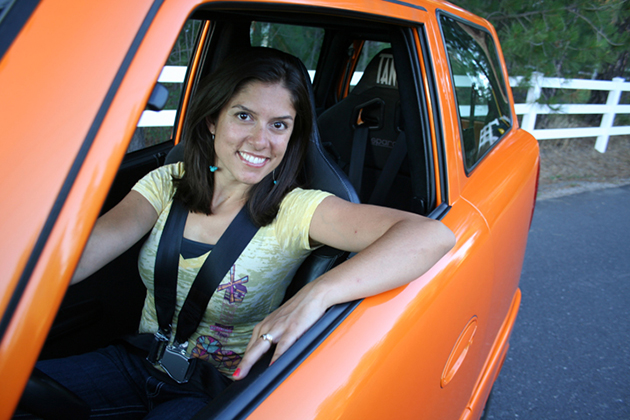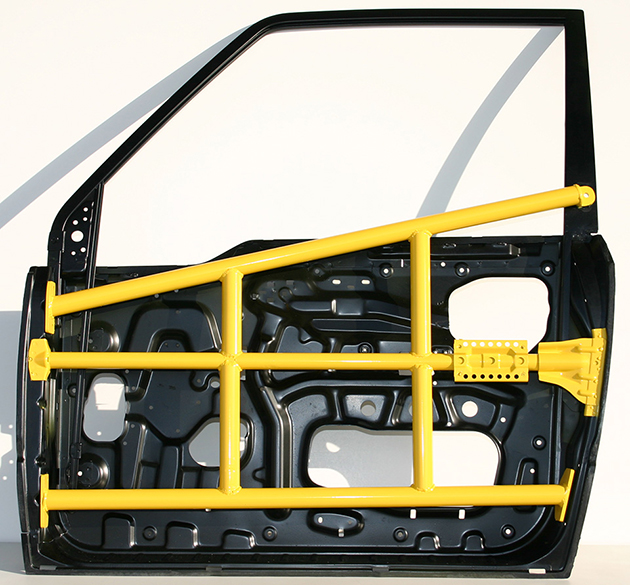

Four-point harnesses, of the same brand and design as used by passenger jet pilots, are standard equipment in a Tango

Only the center cross bar comes standard in a production car. As you can see, we've added two more cross bars that are anchored by specially designed hinges made of billet stainless steel with 3/8" pins in double-shear, meeting double the standard for race cars, as we have two extra cross bars instead of one. At the latch end of the door, there are 1/2" steel pins that link to the rest of the roll cage.

Motors and battery box alone weigh 750 kg. The battery box is made of 10-guage 304 stainless steel. The FIA-certified roll cage that is the chassis is made of 4130 chrome-moly steel DOM tubing. The total weight of the Tango is over 1,500 kg, which is 50 kg more than a Subaru Outback station wagon. So, imagine the equivalent weight of a full sized car, unsurpassed maneuverability, a racecar roll cage, and 4-point safety harnesses. How could you find a safer car?
Safety is job one...
Active Safety:
The statement on the home page: "World's safest car," is a bold statement, of course, and certainly needs some backup. Maybe it would be better described as safest car on the motorway, as safety is a very broad term which could be tested in a myriad of ways.
Safety on the motorway may not be obvious until you've driven the Tango in traffic. Accident avoidance is the key to this safety. To show the opposite extreme, if you've ever driven a truck and trailer, or any kind of car with a trailer on the motorway, you surely remember the helpless feeling that you have if someone wanders into your lane. You can hardly accelerate at all, you can't brake nearly as well, nor can you move over very well to get out of the way, as there is likely a car beside you, leaving you basically no options.
The Tango is basically immune to this situation. First, it can move over, even go between lanes in an emergency. Secondly it can accelerate like a super car, except that with all of the electric torque being absolutely instantaneous, there's no delay, no down shifting, no turbo lag—it just goes, no matter what speed you are already going. Thirdly, having basically the same weight distribution as a 911 Porsche: 43% front and 57% in the rear, braking is excellent, using all 4 wheels more efficiently than a front-engined car, where the front brakes have to do almost all of the work.
Simply put, if you're driving a Tango on the motorway, no other car in history can get out of the way as fast as you can.
This is further proven by the results when Consumer Reports tested the Tango through their Emergency Lane Change Maneuver, also known as the Moose Test, that's famous for rolling over many SUVs and pickup trucks. David Champion, Director of Automotive Testing for Consumer Reports, stated at the Progressive Automotive X-Prize Summit Conference in Ann Arbor Michigan, that the Tango recorded the fastest speed through the test, and that included motorcycles.
Motorcycles and any leaning cars that may come on the market, despite being narrow, cannot maneuver as fast as a Tango, as they must counter-steer, i.e., steering in the opposite direction for a moment in order to lean into the curve needed to avoid an accident. That time could easily be the time that would have been needed to avoid hitting another car or pedestrian that might suddenly appear in one's path.
Furthermore, in the Consumer Reports test, it was possible for the motorcycles and other cars to set up the line through the pylons in order to accomplish the best performance through the test. The Tango was still faster, and yet that test doesn't even take into consideration the time it takes to react to a sudden situation, which is where the Tango excels even more.
Rollover
Rollover stability should be obvious simply by producing the fastest speed through the Moose Test, however, lets go a little deeper. Despite its looks, the Tango certainly has the lowest center of gravity of any car ever built. This is due to the fact that there is approximately 1,000 kg under the floor, the weight of an entire Smart car plus about 200 kg. Because lithium batteries are not as heavy as the original lead-acid batteries, we had to actually add ballast to the bottom of the battery box to achieve a NHTSA 5-Star rollover threshold of 56°, i.e., it will balance on two wheels when heeled over at nearly 60°. That's a lot of bottom-heavy if you compare with a 30-60-90 drafting triangle. A 911 Porsche is almost exactly the same, but looks balanced at that angle, as everyone knows roughly where the center of gravity is on a regular car.
Roll Cage
We have designed the Tango around a roll cage that meets or exceeds FIA racecar regulations. FIA is an international racing sanctioning organization that specifies cage design to protect the occupants of cars crashing at over 300 kph. The Sports Car Club of America, another such organization, requires a single removable door bar to be held by a 3/8" pin in double shear. The Tango has double that requirement with two additional horizontal bars. There are literally over four times more side door protection bars than found in the largest SUVs.
Carbon Fiber Body
There are 100% carbon fiber/epoxy panels over the outside of the chrome-moly steel racecar roll cage keeping a strong and lightweight exterior as used in aerospace and Formula One race cars.
“The significant problems we face cannot be solved by the same level of thinking that created them.”
“The formulation of the problem is often more essential than its solution, which may be
merely a matter of mathematical or experimental skill.”
“If I had an hour to solve a problem I'd spend 55 minutes thinking about the problem and 5
minutes thinking about solutions.”
― Albert Einstein
New Zealand Site
United States Site